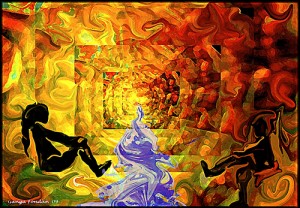“Everything moves. Everything …motion is just a manifestation of going from one spot to another spot in space. When we are trying to understand motion all of the things that we measure from have to come from an inertial frame of reference. An inertial frame of reference is a reference frame that is moving at a constant speed and not changing direction.”
—Motion and Relativity, Dr. Charles Liu, Research Associate @ the Department of Astrophysics, American Museum of Natural History
The backbone of a story, particularly an entertaining and engaging one is motion, movement from one place in conscious and consensual reality to another.
Amplifying the reader’s engagement with the internal movement of the story, the emotional thread requires clarification of setting and displaying the subtle shifts that take place and occur in perception of setting reflective of one’s internal changes.
These changes are usually transmitted, or rather shown through the eyes and physical senses of the protagonist who is also the point-of-view character.
As such the point-of-view character also serves at the character who is being acted upon, the one subject to the chaos created by not simply the dilemma and physical obstacles, but also havoc stirred by the antagonist and other supporting cast.
Maximum engagement with a story by a reader requires the reader to gain a point of identification.
While some of this lies within internal constructs arising from similar personalities traits shared by reader and protagonist, another just as important part of identification rests with the reader’s ability to join with the protagonist from the reader’s inertial frame of reference.
The author’s writing needs to carry the reader at a pace that for the most part keeps her or him connected to the protagonist as if both, though sitting on two trains, move at the same speed. In this way the reader loses all sense of movement. In so doing time in one aspect appears to slow. And yet in another, it feels suspended.
Here lies the paradox of reading, and writing, each built upon the blocks of words that serve as wheels and transport us with out physical movement.
And yet no story worth its salt leaves a protagonist unchanged, stationary, the same at the end of the story as she or he appeared at the outset.
The best stories about internal transformation bolstering and bolstered by external change.
Should this occur, the reader feels stuck, as if she or he has wasted her or his time.
Ever notice how boring stories, though well written grammatically cause us to yawn? Getting through a page seems to require an eternity, another one appearing when we attempt to turn the page.
And yet the novels that so engage our senses and hearts, though dramatically longer, require what seems little effort. Their words, as if passing before our eyes, carry us forward in what seems no time.
Engrossed with the events painted and acted out by the words upon the page, we share and inertial frame of reference with the protagonist. We move as she or he does. And thus seem not to move. We slow down, lose track of time. Hours fly by, we, leaving us, the reader, feeling less the wearier, and more invigorated that when we set eyes upon the first page.
Careful attention to the mechanics of plot, the order of cause-and-effect events shaping the skeleton of our stories propel our fiction in this manner.
This is the physics of words, paragraphs, dialogue and scenes, carefully chosen and artfully ordered.
This is motion both for the reader and the author/writer.


Pingback: Motion, Identification and The Inertial Frame of Reference… « anjuellefloyd